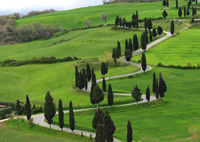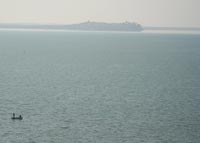 |
Il Perugino, Christ Handing the Keys to St Peter, Cappella Sistina, Vatican, Rome
|
|
Among Perugino's frescoes in the Chapel, the Christ Giving the Keys to St. Peter is stylistically the most instructive. This scene is a reference to Matthew 16 in which the "keys of the kingdom of heaven" are given to St.Peter.[1] These keys represent the power to forgive and to share the word of God thereby giving them the power to allow others into heaven. The main figures are organized in a frieze in two tightly compressed rows close to the surface of the picture and well below the horizon. The principal group, showing Christ handing the silver and gold keys to the kneeling St. Peter, is surrounded by the other Apostles, including Judas (fifth figure to the left of Christ), all with halos, together with portraits of contemporaries, including one said to be a self-portrait (fifth from the right edge). The flat, open square is divided by coloured stones into large foreshortened rectangles, although they are not used in defining the spatial organization. Nor is the relationship between the figures and the felicitous invention of the porticoed Temple of Solomon that dominates the picture effectively resolved. The triumphal arches at the extremities appear as superfluous antiquarian references, suitable for a Roman audience. Scattered in the middle distance are two secondary scenes from the life of Christ, including the Tribute Money on the left and the Stoning of Christ on the right.
|
||
|
Art in Tuscany | Italian Renaissance painting Vatican Museums | Website | mv.vatican.va Virtual Visit of the Sistine Chapel | www.vatican.va Arte in Toscana | Giorgio Vasari, Le vite de' più eccellenti pittori, scultori e architettori (1550) | Pietro Perugino Pietro Perugino and the Trasimeno lake scenary | Renaissance and Mannerism Painting in Città della Pieve, Paciano, Panicale and Castiglione del Lago |
[1] The stories of Christ were originally distributed over eight panels, each one presented by a title in the upper frieze. They began with the Nativity painted by Perugino on the altar wall, subsequently destroyed to make room for Michelangelo's Last Judgement. Thus, today, the events of the life of Christ start from his Baptism, which is followed by the Temptations of Christ and the Cleansing of the Leper. The third shows in the foreground the Calling of the Apostles Peter and Andrew, while the Call of James and John is shown in the background. The next fresco illustrates the Sermon on the Mount and the curing of the leper, while the fifth shows the Handing over of the keys, that is to say the transfer of power from Christ to Peter, his vicar, as well as the two episodes of the Payment of the tribute and of the Attempted stoning of Christ in the background. The series on this wall ends with the Last Supper in which, beyond the windows we can see three episodes of the Passion: the Agony in the garden, the Arrest of Jesus, the Crucifixion. The cycle ends with the Resurrection of Christ on the entrance wall. |
| This page uses material from the Wikipedia article Sistine Chapel, published under the GNU Free Documentation License. |
 |
||||
The Val d'Orcia stretches from south of Siena to Monte Amiata. The valley plain is a classic example of the Tuscan landscape, with endless hills, cypresses, wine, corn fields and streams. |
||||
|
||||
Podere Santa Pia |
Podere Santa Pia |
Podere Santa Pia, garden view, April |
||
Lago Trasimeno |
Rocca d'Orcia |
San Quirico d'Orcia, Leonini Gardens |
||
 |
 |
|||
Cortona |
Pienza, Piazza Pio II |
Cipress road near Montichiello |
||
Even today the Maremma remains a largely undiscovered gem in the heart of Italy, sandwiched between the stunning Monte Amiata on its eastern fringes and the beautiful Tyrrhenian coast to the west.
|
||||
 |
||||
Podere Santa Pia offers the most exclusive privacy to enjoy a breathtaking view and have a comfortable, regenerating holiday
|
||||








